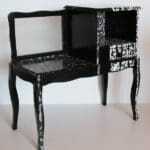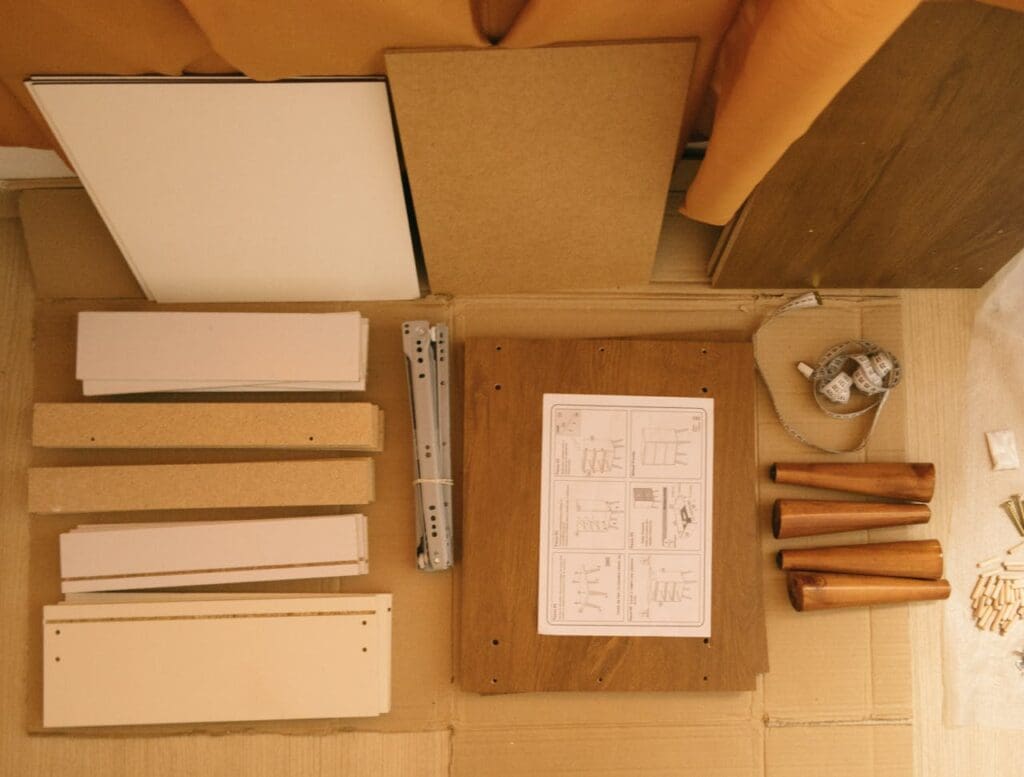In this post: We dig into the topic of fast furniture, what it is, why it's a problem, and what you can do about it.
The Home Green is reader-supported and may receive a commission if you decide to purchase through a posted link. There is no cost to you.
Fast furniture: a tale of woe
It all started with a global pandemic. Like many of us, I had more time on my hands than usual, and it was all spent in my home. So I got a little itchy to tackle those home projects that I had never quite gotten around to.
Project numero uno was making our guest room someplace that I’d actually feel proud to invite a guest to stay. Luckily, I had most of what I needed including a headboard, curtains, and linens repurposed from other rooms in the house. But what I didn’t have were nightstands, so I did something that became second nature during COVID: I hopped on the internet. After a bit of searching, I ordered two of what I deemed to be the best combination of price, looks, and availability.
About a week later, I watched as a delivery person pulled up to my house and literally dropped two nightstand sized boxes off a truck, dragged them to my front door, and sped off. Unsurprisingly, when I opened the boxes, the nightstands had sustained some serious damage from the fall. The company had an established process for this type of situation and happily sent me 2 new, undamaged replacements.
There are many ways to look at this story but one that has crossed my mind a lot since this happened is how much waste was created via this decorating project. If I multiply the impact of my decorating misadventure by all the households that need furniture, it is clear this is not a sustainable situation.
What is fast furniture
It turns out, the problem of mass-produced, lower-quality furniture has become such a concern that it’s resulted in the creation of a new reference category: fast furniture. The fast furniture designation mirrors the term used in the fashion industry to refer to low-cost, readily available, and trend-driven pieces designed for temporary use.
What’s wrong with fast furniture
The fast furniture problem is tied up in the very attributes that have made it so successful. The fast furniture model promotes a cycle of buying, discarding, and replacing furniture faster than ever before, leading to a host of environmental and social issues.
One of the primary concerns is the waste generated by discarded fast furniture. The EPA measures the amount of furniture discarded by Americans each year and has found that we are throwing out 80% more furniture than we did when they began tracking in 1960. Much of this is mass-produced fast furniture.
Beyond the problem of disposal, the production of fast furniture involves resource-intensive processes, from harvesting raw materials to manufacturing and transportation of finished products. This not only depletes natural resources but also contributes to pollution and greenhouse gas emissions, further compounding the environmental impact.
Finally, a problem with fast furniture is that it can often involve the use of toxic materials that can emit volatile organic compounds (VOCs) in your home and have negative impacts on your health. Older furniture is less likely to have harmful emissions. Additionally, thoughtful and high-quality manufacturers are more likely to carefully consider the quality and safety of their products.
Know the signs: how to recognize fast furniture
While there are no hard and fast rules as to what constitutes fast furniture, there are some qualities that are less eco-friendly and point a particular piece toward this category. They include:


Low price point
Fast furniture is typically characterized by the low price point they charge for a newly manufactured piece. These low prices are often achieved by compromises in materials and craftsmanship, and a goal to minimize costs rather than maximize durability.


Cheap materials
Many fast furniture items are made from particleboard, MDF (medium-density fiberboard), or other engineered woods, since they are cheaper than solid wood. These materials are often combined with veneers, laminates, and synthetic finishes to create an appealing exterior that masks the inferior quality of the underlying materials.


Trend focused
A hallmark of fast furniture is a focus on what's popular now. Fast furniture manufacturers frequently update their offerings to reflect current design trends, encouraging consumers to continually replace their furniture.
Life in the slow lane: alternatives to fast furniture
For anyone looking to move away from fast furniture, the good news is that there are many viable alternatives that offer style, sustainability, and affordability. Some alternatives to fast furniture include:
Invest in quality
Looking for durable furniture, particularly that’s locally made, is also a great option. Though the initial cost may be higher, the longevity of these pieces often results in a lower cost per use over time, making them a more economical choice in the long run.


Do a little DIY
For those with a creative streak, DIY furniture projects offer a sustainable and personalized alternative. Upcycling existing furniture or using reclaimed materials to create new pieces not only minimizes waste but also allows for customization that reflects your individual style.


Embrace the second-hand market
One of the best ways to find low prices on high-quality products is to consider secondhand. Thrift stores, vintage shops, and online marketplaces are treasure troves of unique, high-quality furniture items that can add character and charm to any space – with a lower environmental footprint. Purchasing second-hand not only extends the life of existing furniture but also reduces the demand for new, fast furniture pieces.


What if I already own fast furniture?
If, like me, you now realize that you already own fast furniture, the important thing is to do what you can to minimize the impact of this past decision. Some ideas to do this include:
- Repair and maintain. Instead of discarding furniture at the first sign of wear or damage, stay on top of repairing and maintaining it. This extends the lifespan of your furniture and reduces the need for new purchases.
- Resell or donate. Fast furniture or otherwise, If you no longer have a use for a particular piece of furniture, consider reselling it online, giving it away to a friend or neighbor or donating it to a charitable organization. This gives the furniture a second life and reduces waste.
- Find a new space. If you bought a cheap piece of furniture that you’re no longer happy featuring prominently in your home, consider if it might have use in a less visible space. Places like basements and garages can often benefit from storage options and reusing a piece you already own means you won't contribute to further environmental impact.
- Responsible disposal. If you do need to dispose of furniture, do so responsibly. Explore recycling options for materials like wood, metal, or plastic, and avoid simply dumping furniture in landfills.
- Learn from your mistakes. consider your long-term journey with the pieces you buy, not just the short-term need. Is this piece of furniture likely to suit my needs for years into the future? If I no longer need it, will it be difficult to find it a new home? How likely is it that this purchase will hold up to years of use? Trying to buy higher quality pieces and supporting eco-friendly furniture manufacturers is a great way to have a gentler impact on the planet.
For more info on our favorite sustainable furniture manufacturers, check out our full article.
Conclusion
When it comes to fast furniture, there are many ways that our decisions at the household level can help reduce the challenges created by mountains of cheap goods. Until the true cost of fast furniture is reflected in the purchase price, it can be tempting to prioritize short-term needs when furnishing your home. What I’ve discovered is that there actually are a lot of other great options and that by considering the full life of the furniture I bring home instead of just the purchase step, I’m able to make better choices for me and for the planet as a whole.
Other articles you may enjoy
Free tips and inspiration in your inbox
Enter your email address below to receive the latest news from The Home Green.






